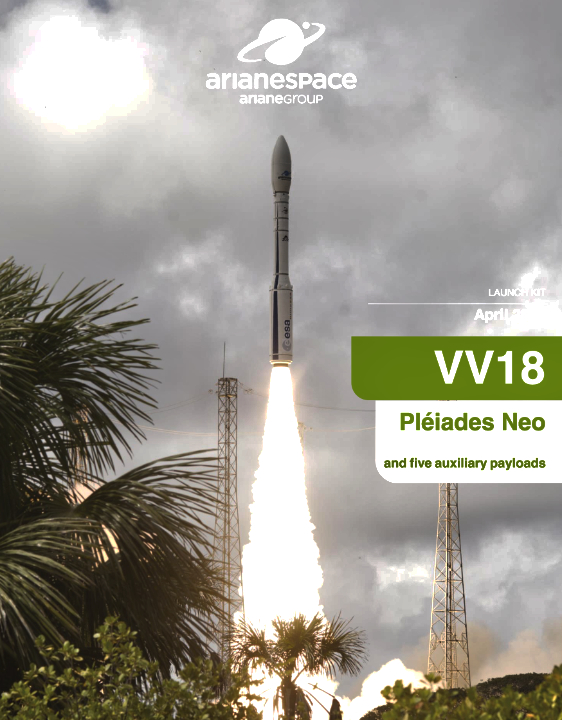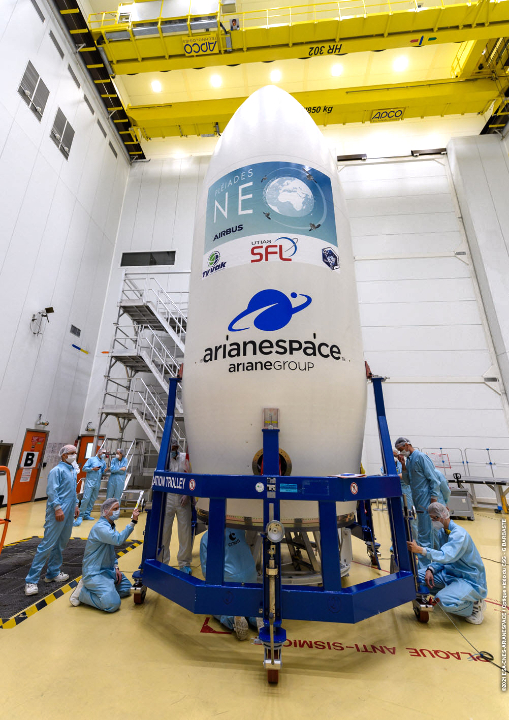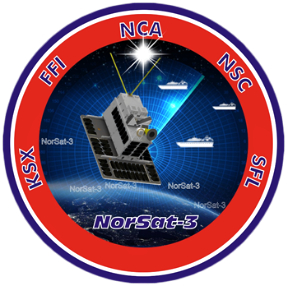
On Wednesday, April 28, 2021, at 10:50 pm local time (01:50 UTC on Thursday, April 29), a Vega launch vehicle operated by Arianespace lifted off successfully from the Guiana Space Center, Europe’s Spaceport in French Guiana (South America) –this mission marked Vega’s return to flight and was also the second successful launch by Arianespace’s teams in less than 72 hours.

The mission’s primary purpose was to orbit Pleiades Neo 3, the first of four satellites in an advanced EO constellation. Pleiades Neo 3 was wholly funded and manufactured by its operator, Airbus.

Arianespace’s 18th Vega mission also deployed several smallsats using the company’s rideshare service SSMS (Small Spacecraft Mission Service). These auxiliary payloads included an observation smallsat for the Norwegian space agency, Norsat-3, and four cubesats for the operators Eutelsat, NanoAvionics/Aurora Insight and Spire.


The SSMS rideshare service, developed with the support of the European space industry, was first deployed by Arianespace in September of 2020. Funded by the European Space Agency (ESA), Arianespace’s SSMS service will soon be joined by the Multiple Launch Service (MLS), a similar offering that uses the Ariane 6 launch vehicle. With these two services, Arianespace can offer a wide range of affordable launch opportunities for small satellites and constellations.
The production of the Vega launcher and preparations for mission VV18 were handled by Avio, industrial prime contractor for the Vega launcher, under the direction of Arianespace and ESA. They followed all recommendations issued by the Independent Inquiry Commission set up after the failure of the 17th Vega mission (VV17).

VV18 is the third Arianespace mission of 2021, following two successful Soyuz launches, on March 25 and April 26, from the Vostochny launch base in Russia.
Vega is a new-generation light launcher, perfectly suited to both commercial and government payloads. Because of its high performance and versatility, Arianespace provides the best possible launch solution for small and medium spacecraft headed into a wide range of orbits (Sun-synchronous, ballistic, transfer to the Lagrange point L1, etc.), for EO, science, education, defense and other applications. With Vega C, Arianespace will offer enhanced performance and greater payload volume for future customers at the same price as for launches by Vega.
“I would like to congratulate everybody involved at Arianespace, ESA and Avio for successfully returning Vega to flight,” said Stéphane Israël, Chief Executive Officer of Arianespace. “I am especially proud of our teams who were able to carry out two launches, on two different continents, in less than 72 hours – kudos!”
The AVUM stage will ignite its engine for the first time, in a powered phase lasting about eight minutes, followed by a ballistic phase lasting 37 minutes. The AVUM stage will then restart its engine for a second burn lasting a little over one minute, before releasing the Pleiades Neo 3 satellite.
The next two AVUM ignition phases will last about 37 minutes in all, followed by the release of the five auxiliary payloads. That will mark the end of mission VV18, one hour and 42 minutes after liftoff.
The first of four satellites in an advanced EO constellation, Pleiades Neo 3 was wholly funded and manufactured by its operator, Airbus. The 18th mission of Europe’s Vega light launcher will also orbit an observation smallsat for the Norwegian space agency, Norsat-3, plus four cubesats for the operators Eutelsat, NanoAvionics/Aurora Insight and Spire. These smallsats will be carried as auxiliary payloads on the innovative Small Spacecraft Mission Service (SSMS) deployment system. The SSMS rideshare service, developed with the support of the European space industry, was first deployed by Arianespace in September 2020.
Funded by the European Space Agency (ESA), Arianespace’s SSMS service will soon be joined by the Multiple Launch Service (MLS), a similar offering that uses the Ariane 6 launch vehicle. With these two services, Arianespace can offer a wide range of affordable launch opportunities for small satellites and constellations.
The production of the Vega launcher and preparations for mission VV18 were overseen by Avio, the prime contractor for the Vega launcher, under the direction of Arianespace and ESA. They followed all recommendations issued by the Independent Inquiry Commission established after the failure of the 17th Vega mission (VV17).
About the Pléiades Neo 3 satellite
Pléiades Neo 3 is the first of the Pléiades Neo constellation to be launched. Entirely funded, manufactured, owned and operated by Airbus, Pléiades Neo is a breakthrough in Earth observation domain.
With 30 cm resolution, best-in-class geolocation accuracy and twice-a-day revisit, the four Pléiades Neo satellites unlock new possibilities with ultimate reactivity. Thanks to these state-of-the-art satellites, each step of the acquisition and delivery cycle offers top-level EO services now and going forward for the next ten years. In addition, their reactive tasking ability allows urgent acquisitions 30 to 40 minutes following request – which is five times higher than previous constellations – and respond to the most critical situations in near real-time, very useful for natural disaster. Pléiades Neo will also operate for mapping, urban and defence applications.
The Pléiades Neo constellation is 100% commercially available and will provide institutional and commercial customer’s needs. Images captured by Pléiades Neo will be streamed into the OneAtlas on-line platform, allowing customers to have immediate data access, analytics and correlation with Airbus’ unique archive of optical and radar data.
There are two additional Airbus Defence and Space Intelligence missions for three satellites in the Arianespace backlog to be launched on Vega from the Guiana space center.
Pleiades Neo 3 will be the 131st Airbus Defence and Space built satellite to be launched by Arianespace. There are currently 20 Airbus Defence and Space built satellites in Arianespace’s backlog: CERES (x3), SYRACUSE 4B (COMSAT NG 2), EUTELSAT QUANTUM, METOP-SG A1 & METOP-SG B1, THEOS-2, CSO 3, Pléiades Neo (x3), JUICE, Measat-3d, Biomass, EarthCARE and CO3D (x4). In addition, Airbus Defence and Space is involved in the construction of the OneWeb satellites.
